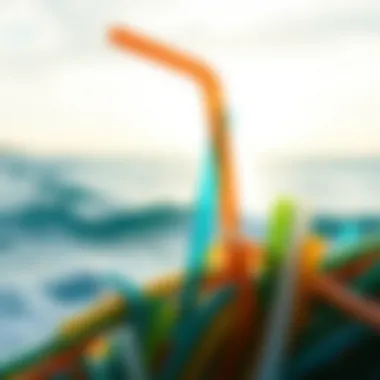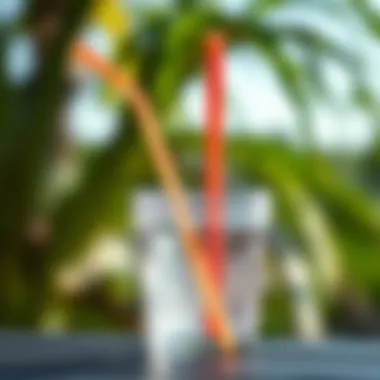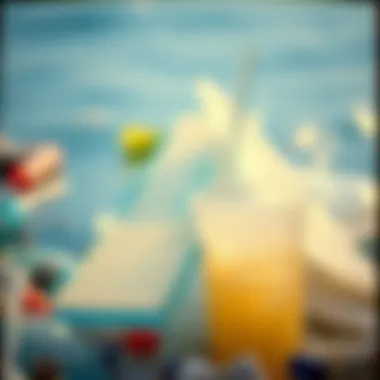The Environmental Impact of Plastic Straws


Intro
Plastic straws have become a symbol of the damage single-use plastics can bestow upon our oceans and the wildlife that inhabits them. Their prevalence in our daily lives—often associated with quick sips of a cold drink—belies the devastating environmental repercussions tied to their use. It might just seem like a simple convenience, but when we peel back the layers, we uncover a more complex narrative intertwined with marine pollution and ecosystem degradation.
For instance, consider the lifecycle of a plastic straw. What happens once it's discarded? Many of these veer off into landfills, or worse, wash into waterways, eventually making their way to vast oceans. Here, they twist into the fabric of ocean waste that threatens marine fauna. A surprising statistic to ponder is that an estimated 1 billion straws are used every day in the United States alone. This is a staggering figure when taking into account the broader implications on marine conservation and ecological health.
Moreover, advancing awareness around these impacts calls for a cultural shift—not just in how we regard our habits with plastic straws, but also in our approach to sustainable practices prevalent in surf culture. Surfers and environmental advocates are uniquely positioned to lead this charge, as they inhabit a world where the ocean is central to their lifestyle. By confronting their plastic use, especially with straws, they can catalyze changes that resonate widely, ultimately working towards a healthier planet.
Understanding Plastic Waste
The significance of comprehending plastic waste cannot be overstated, especially in discussing the impact of plastic straws on the environment. Understanding what plastic waste consists of, along with its long-lasting effects, lays the groundwork for recognizing how individual choices contribute to a larger crisis.
By unpacking the concept of plastic waste, we can better appreciate the broader ramifications on ecosystems and community health. Each piece of plastic, no matter how small, adds to the growing mountain of waste that often finds its way into oceans and waterways, further threatening marine life and habitats.
Here are key aspects that highlight the importance of understanding plastic waste:
- Environmental Impact: Knowing the specifics about plastic waste can help individuals and organizations develop strategies to minimize their contribution to the problem. For example, adopting alternatives to plastic straws can lead to significant reductions in single-use plastic consumption.
- Public Awareness: A well-informed public can spark meaningful discussions and movements towards sustainable practices. The more people know and understand about plastic waste, the more likely they are to advocate for change.
- Legislation and Policies: By understanding the components of plastic waste, consumers can push for better policies at local and national levels, urging governments to impose stricter regulations on plastic production and disposal methods.
Definition of Plastic Waste
Plastic waste is defined as any plastic material that is discarded, unwanted, or no longer useful. It can come from various sources, including consumer goods, packaging, and industrial processes.
Plastics are made from synthetic or semi-synthetic materials, which makes them durable and resistant to degradation. However, this very durability leads to long-term environmental hazards. Most plastics can take hundreds to thousands of years to decompose fully. Plastic waste poses a threat to wildlife and natural habitats, as it often becomes litter, polluting landscapes and waterways.
Types of Plastics in Use
Plastics can be categorized into several types, each with its unique properties and applications. Here’s a breakdown of the most commonly used types of plastics:
- Polyethylene (PE): Commonly used in grocery bags, plastic bottles, and food containers. It's lightweight but often ends up in landfills or oceans.
- Polypropylene (PP): Used in food packaging, automotive parts, and reusable products, like straws. It’s more durable than PE but still problematic when disposed of incorrectly.
- Polyvinyl Chloride (PVC): Found in piping, credit cards, and medical equipment; it's challenging to recycle due to its additives, which can be harmful.
- Polystyrene (PS): Commonly used for disposable cups and packaging. It's notoriously difficult to recycle and can break into harmful microplastics.
Statistics on Plastic Consumption
The statistics surrounding plastic use are staggering and paint a grim picture:
- Annual Production: According to data from the PlasticsEurope Association, in 2020, approximately 368 million metric tons of plastic were produced globally. The numbers have consistently risen over the decades, doubling from the period of 2000 to 2020.
- Waste Generation: The World Bank estimates that by 2030, the world will generate 2.2 billion tons of solid waste a year, much of which will be plastic.
- Ocean Contribution: Reports suggest that between 4.8 and 12.7 million metric tons of plastic enter the oceans each year, with a significant portion being from single-use plastics like straws.
Understanding plastic waste not only sheds light on the immediate issues affecting our environment but also prompts action towards sustainability. Knowing the facts equips individuals and communities to make informed choices that contribute to a healthier planet.
The Journey of Plastic Straws
The journey of plastic straws is more than just a tale of a consumable object; it's a narrative that intertwines with environmental stewardship, innovation, and cultural shifts. Understanding this journey helps to highlight not only how these items contribute to plastic waste but also the potential pathways to mitigate that impact. By examining both the manufacturing and lifecycle of plastic straws, we can unpack essential insights into their environmental ramifications and inspire a change in consumer behavior.
Manufacturing Process of Plastic Straws
The manufacturing process of plastic straws might seem straightforward, but it involves a series of steps that spell out the environmental cost tied to these seemingly innocuous items. Plastic straws are mainly made from polypropylene or polystyrene, which are derived from fossil fuels. The process begins with extracting oil, the primary raw material, which is then transformed into plastic granules through refining and polymerization. Once the granules are ready, they are heated and shaped through a process known as extrusion.
During extrusion, the molten plastic is forced through a die to form the tubular shape of straws. After cooling, they are cut to desired lengths and packaged for distribution. What is critical to note is the scale of production: in the United States alone, it's estimated that around 500 million straws are used daily. Each straw represents a piece of a sprawling supply chain that has significant energy and resource costs, leading to fossil fuel depletion and greenhouse gas emissions. This phase in the journey sets the tone for what happens next, as each straw proceeds from the factory to your favorite café.
Lifecycle of a Plastic Straw
Once manufactured, a plastic straw's lifecycle unfolds in several predictable stages. First, it enjoys its short-lived moment of utility in fast food joints, beach bars, or at casual gatherings. However, this brief use belies its long-lasting impact. After about 20 minutes of sipping a soda or a smoothie, the straw often meets its fate in the trash. If one digs a bit deeper, they’ll find striking statistics: roughly 79% of all plastic produced in the world ends up in landfills or the environment, including oceans, where a significant chunk of plastic debris originates.
As plastic straws break down, they do so into smaller fragments called microplastics, which can be harmful to marine life and ecosystems. These tiny particles enter the food chain, with serious implications for human health as well. Notably, studies have shown that when marine animals ingest plastics, they may suffer internal injuries or blockages, leading to a painful demise.
Moreover, the ongoing lifecycle of these straws prompts us to reflect on our consumption habits. As surfers or nature lovers, each choice we make about single-use plastics feeds into a larger narrative about our impact on the ocean. Understanding the journey of plastic straws isn’t just an exercise in environmental education; it is a call to action. Collectively, we can decide how this story unfolds next.
"Knowing the path of a plastic straw from production to disposal can shift our thinking on how to choose alternatives."


To combat the negative effects of plastic straws, society has begun to consider alternatives such as glass, metal, or biodegradable options. Each choice brings its own set of benefits and challenges. By examining the full journey of a plastic straw, we can better appreciate the gravity of our choices and work towards a sustainable future.
Impact on Marine Life
The impact of plastic straws on marine life cannot be understated. These seemingly trivial items coalesce into a serious dilemma for the world’s oceans. With millions of straws discarded every day, their presence is firmly entrenched in the marine ecosystems. This section delves into the depth of the issue, highlighting just how significant the situation is for marine species and their habitats.
Statistics on Marine Pollution
To grasp the gravity of marine pollution, one only has to glance at the numbers. According to recent studies, an estimated 8 million metric tons of plastic end up in the oceans each year. Furthermore, plastic straws make up a considerable percentage of that figure. In 2018 alone, it’s believed that about 1 billion plastic straws were used in the United States—a staggering number that showcases the ease and prevalence of single-use plastics in daily life.
When one considers that these straws do not biodegrade, but rather break down into microplastics, the problem morphs from an immediate crisis to a long-lasting one.
Effects on Marine Species
Ingestion by Marine Animals
When marine animals encounter plastic straws, ingestion is often an unfortunate consequence. Species such as sea turtles, which mistake these items for food, are particularly vulnerable. When turtles ingest plastic, it can lead to blockages in their digestive systems, often resulting in malnutrition or even death. The alarming part is that studies show nearly 52% of sea turtles have ingested plastic debris at some point in their lives.
Moreover, the ingestion of plastics disrupts various biological processes in these animals. The key characteristic here is the confusion between natural prey and plastic waste, which leads to critical health risks for marine species, ultimately disrupting the marine food web. The unique feature of ingestion is that it not only harms individual animals, but it also puts entire populations at risk. The disadvantages are evident; ecosystems face potential collapse if key species decline significantly.
Entanglement Issues
Entanglement presents another dire threat to marine life. Plastic straws, while not the primary culprits, can still lead to entrapment. For example, animals like seals and seabirds can become entwined in a mix of trash, including plastic straws. This entanglement restricts movement and can lead to fatal injuries or starvation. Additionally, an alarming statistic reveals that marine mammals are found entangled in gear made from various other materials, showing a pattern of rising incidents involving marine debris.
The characteristic here is that these entrapments can occur silently, often without immediate observation by humans. The unique features of entanglement include suffocation and severe injuries. This draws attention to how plastic waste affects the marine ecosystem over time. On examining its broader impact, one notices the harmful effects stretch beyond individual suffering—entangled creatures prevent densely populated areas from thriving, ultimately impacting biodiversity.
Long-Term Ecosystem Changes
If plastic straws, along with other plastic waste, persist in the oceans, the long-term implications could alter entire ecosystems. Marine habitats like coral reefs and ocean floors take the brunt of this change. Straws and other plastic debris often lead to the degradation of delicate environments, which play crucial roles in maintaining marine biodiversity.
An ecological shift occurs when certain species are forced to adapt or perish due to the changing conditions caused by pollution. The consequences don't stop here; they circulate through the food chain, affecting not only sea life but also those who rely on the oceans for sustenance, including millions of people. Thus, it is vital to draw attention to the fragile balance within marine ecosystems and the necessity for immediate action against plastic pollution.
“Conserving the ocean means preserving a vital source of life and ecological stability.” – Ocean Conservation Group
By understanding the magnitude of the issue of plastic straws in the oceans, we can better inform ourselves and look toward solutions that foster a healthier marine environment. A concerted effort is needed to raise awareness and instigate change across communities, especially among those who cherish activities tied to the ocean, like surfing.
Cultural Perceptions of Plastic Straws
Understanding cultural perceptions surrounding plastic straws is vital to grasp the broader context of their environmental impact. Straws symbolize convenience in our fast-paced society. Yet, their ease of use comes with significant ecological considerations that many people overlook. As awareness grows about plastic pollution, a shift in how straws are viewed and utilized becomes increasingly essential.
The Rise of Plastic Straw Usage
The proliferation of plastic straws can be traced back to the mid-20th century when the convenience of single-use plastics captured the imagination of consumers. Back then, straws weren’t just additions to beverages; they were a sign of modernity and style. Fast food chains embraced these plastic wonders, making them a staple in dining experiences.
In the 1980s and 1990s, marketing campaigns targeted young, hip consumers, linking the use of colorful straws to fun and adventure. This led to an explosion in consumption, contributing to a culture where the ease of access to straws overshadowed their detrimental impacts. Over time, these disposable items became ubiquitous in cafes, bars, and homes.
However, as the plastic pollution crisis has gained attention, the once widely accepted notion of straws as harmless tools is being re-evaluated. Important questions emerge:
- What is the true cost of convenience?
- Are we sacrificing our oceans for a fleeting moment of enjoyment?
Plastic Straws in Surf Culture
In surfing culture, the conversation surrounding plastic straws is uniquely significant. Surfers often find themselves intertwined with nature, riding the waves and breathing in ocean air. Unfortunately, they also face the harsh realities of pollution littering their beloved beaches. Plastic straws, often discarded carelessly, contribute to the marine debris found across coastlines.
Many surfers are beginning to take a stand on this issue, linking their sport's sustainability to their actions. Some local surf shops have taken initiatives to stop selling plastic straws, swapping them instead with eco-friendly alternatives. This shift is not just about aesthetics; it’s about harmony with nature.
Surfers are active ambassadors for change. The community hosts beach cleanups, bringing awareness to the detrimental effects of plastic waste. By embracing sustainable practices, surfers are not merely addressing their habits but also working to change the perceptions around plastic in their cultural sphere.


"Every time a surfer chooses a sustainable straw, they're making a choice for the ocean. It's more than just a sip—it's a statement."
In summary, cultural perceptions of plastic straws have evolved from symbolizing a carefree lifestyle to representing a pressing environmental issue. As surfers and other communities reconsider their choices, they play an integral role in crafting a more sustainable future.
Alternatives to Plastic Straws
The conversation surrounding plastic straws cannot progress without considering viable alternatives. The move away from using plastic straws not only addresses the issue of pollution but also sets the stage for a more sustainable lifestyle. In this section, we'll dive into various materials that can substitute plastic straws, exploring both their benefits and potential drawbacks.
Material Options Available
Glass Straws
Glass straws have gained momentum in recent years. One could say they are a shining star amidst the plastic debris. Their key characteristic is transparency, which makes them not just functional but also aesthetically pleasing. They elevate the drinking experience; that’s something special when siping on a cold beverage while watching the waves crash.
What makes glass straws stand out is their reusability. When properly cared for, they can last indefinitely, significantly reducing waste. They are easy to clean, often dishwasher-safe, and do not retain flavors or odors. However, they tend to be fragile. A careless drop could shatter one into pieces, which can be a downside for those on the go.
Metal Straws
Metal straws, often made of stainless steel, are another popular choice. Their sturdy nature is a major selling point. You can bend them, clank them, and when treated well, they can last a lifetime—compare that to single-use plastic straws, which often end up wafting around oceans for centuries.
Most metal straws come with cleaning brushes, making them a breeze to maintain. One aspect that people sometimes overlook is the temperature; these straws can get quite hot if used with hot beverages or frosty cold if sipping on ice drinks. But for many, that doesn’t outweigh the positives. They are seen as a bold statement against wastefulness.
Bamboo Straws
Now let’s talk about bamboo straws; these are as close to nature as you can get without breaking the bank. Their remarkable characteristic is that they are entirely biodegradable, making them a darling among environmental advocates. Bamboo is a fast-growing grass that thrives without pesticides, adding an eco-friendly element to your sipping habits.
Bamboo straws have a unique rustic charm; using one invokes a simpler lifestyle, something many people seek today. They’re lightweight and easy to carry around. On the flip side, they can wear down quicker than glass or metal straws, requiring more frequent replacements. This is something to consider if sustainability is your primary concern.
Reusable vs. Disposable
The battle between reusable and disposable alternatives is ongoing. Reusable options, like glass, metal, and bamboo straws, prove to be economical and environmentally friendly over time. However, disposable options, such as paper or plant-based straws, can be convenient for events or beach outings where dishwashing can be a hassle. The key is to evaluate the usage context: in settings promoting sustainability, opting for reusable straws makes a compelling statement.
In summary, the alternatives to plastic straws present several paths toward reducing environmental impact. Choosing the right type comes down to personal preference, lifestyle, and commitment to sustainability.
Legislation and Initiatives
The world is waking up to the environmental crisis fueled by plastic pollution, and plastic straws are a significant player in this drama. Initiating legislation and grassroots initiatives to mitigate plastic usage is vital for sustaining our marine ecosystems and keeping coastlines pristine. Understanding these efforts gives us insight into how collective action can produce meaningful change.
Bans on Plastic Straws
Several regions around the globe have begun enforcing bans on plastic straws, aiming to reverse the damage that they inflict on oceans and wildlife. These bans serve a dual purpose: they urge consumers to reconsider their choices while also spotlighting the wider plastic problem. Some key moments include:
- California made headlines as one of the first states to legislate against plastic straws in restaurants, making it clear that change is more than just lip service.
- In Europe, the European Union has announced plans to outlaw certain single-use plastics, including straws, pushing member countries to adopt more sustainable practices.
- Cities like San Francisco and Seattle have pioneered local bans, inspiring other urban areas to follow suit.
"Legislation is more than regulation; it’s the voice of the community advocating for change."
The effectiveness of these bans, however, relies heavily on compliance and public awareness. Phasing out plastic straws alone won’t fix the issue. It needs to be accompanied by educational campaigns and the offering of solid alternatives to genuinely shift consumer behavior. The bans create a platform for further environmental discourse; without this discourse, the ban may just be seen as another hurdle for businesses rather than a necessary evolution for our planet.
Community Initiatives for Reduction
Communities play a pivotal role in the fight against plastic straws and their detrimental effects on the environment. Grassroots initiatives often foster connections between residents, businesses, and local governments. Here’s a look at how these community-driven efforts can cultivate change:
- Local Clean-Up Events: Organized beach clean-ups not only help in removing plastic from nature but also raise awareness about the impact of plastic pollution, inspiring participants to rethink their consumption habits.
- Educational Workshops: Local environmental groups host sessions to discuss why reducing single-use plastics, such as straws, benefits the community and the environment. This educational push empowers others to make informed choices.
- Eco-Friendly Business Challenges: Communities can motivate local businesses to switch to sustainable alternatives by hosting challenges or competitions where businesses that reduce plastic straws or implement alternative measures get recognized.
By participating in community initiatives, individuals feel empowered, knowing that their choices can make a difference. It’s a collective movement that emphasizes shared responsibility and encourages everyone to pull together for the common good. This not only strengthens community bonds but also creates a ripple effect that could encourage others beyond local borders.
In the end, whether through legislation or local initiatives, transforming how we manage and perceive plastic straws is essential for safeguarding marine life. The future doesn’t solely rest on the shoulders of policymakers or environmental organizations; every individual has a part to play. Therefore, being engaged and informed is crucial to this ongoing struggle against plastic pollution.


The Role of Educating Surfers
Educating surfers about the environmental impact of plastic straws is crucial in tackling ocean pollution. Surfing is not just a sport; it’s a lifestyle deeply intertwined with nature. Regular interaction with the ocean fosters a sense of awareness and responsibility. Thus, surfers have a unique platform to lead the charge against plastic waste. By embracing sustainable practices, surfers can significantly contribute to the health of marine ecosystems.
The dynamic nature of surf culture presents an opportunity for advocacy. As surfers advocate for cleaner oceans, understanding the role of plastic straws in marine pollution becomes paramount. Engaging with this issue isn’t merely about avoiding plastic straws; it signifies a broader commitment to environmental stewardship.
Educating on Environmental Practices
To make a real impact, surfers must be equipped with knowledge about environmental practices. Education can occur through various avenues, such as:
- Surf Schools: Incorporating environmental modules into the curriculum.
- Community Events: Hosting beach clean-ups where discussions on the effects of plastic pollution can take place.
- Social Media Campaigns: Utilizing platforms like Facebook and Instagram to share insights, eco-friendly tips, and personal stories.
Surfers often talk about the wave of excitement during their sessions, but it’s essential to balance that thrill with reflection on what happens when they leave the water. Knowledge about how little changes, like carrying reusable straws or picking up trash after a session, can lead to significant environmental improvements is a game-changer.
"The health of our oceans reflects the health of our surfing community; each wave we ride adds to our responsibility toward nature."
Promoting Sustainable Surfing
Promoting sustainable surfing is an extension of educating surfers. Beyond understanding the problem, it’s about taking active steps towards solutions. Some key elements include:
- Advocating for Eco-Friendly Gear: Surfers should consider products made from sustainable materials, such as eco-friendly surfboards and wetsuits.
- Choosing Responsible Brands: Emphasizing the importance of supporting companies committed to reducing plastic usage, like those who create biodegradable wax or eco-friendly accessories.
- Encouraging Minimalism: Adopting a less is more philosophy when it comes to equipment, ultimately reducing the plastic footprint.
Surfers can embrace change not just in their personal habits, but also in their communities. For instance, organizing local surf competitions that focus on sustainability can inspire participants and spectators alike. Integration of eco-awareness into surf events fosters a culture that prioritizes the environment.
The Future of Straws in Surfing
The topic of the future of straws in surfing is more than just a passing fad or trend—it's a movement toward sustainability that aligns with broader environmental goals. As the surf culture embraces eco-friendliness, understanding how the adoption of alternatives to plastic straws can shape beach etiquette and ocean conservation is fundamental. The change is not just about the straws themselves, but also about fostering a cultural shift among the surfing community, emphasizing that every small action contributes to a larger impact on our oceans.
Innovations in Biodegradable Materials
Emerging innovations in biodegradable materials are revolutionizing the way surfers and consumers think about straws. These materials are designed to decompose naturally and minimize their impact on the environment when disposed of. Here are some noteworthy developments:
- Plant-Based Polymers: Made from renewable resources like cornstarch or sugarcane, these materials break down more efficiently compared to traditional plastics. They are strong yet compostable, making them a suitable alternative for both surf enthusiasts and casual beachgoers.
- Organic Bamboo Straws: Bamboo, being one of the fastest-growing plants on earth, provides a synergistic solution. Not only are they biodegradable, they’re also sturdy and come with a natural aesthetic, resonating well with the surf culture’s organic vibe.
- Edible Straws: Perhaps the most peculiar and exciting innovation is the rise of edible straws. These colorful creations can be made from natural ingredients like seaweed or rice, allowing consumers to enjoy their drink and then consume the straw. This serves a dual purpose of reducing waste and providing a fun, unique experience for surfers looking to quench their thirst after hitting the waves.
The adoption of these materials could lead to a renaissance in how surfers engage with their environment. Embracing biodegradable straws can serve as a gateway for broader discussions about sustainability practices within surf culture.
Behavioral Shifts in Consumer Choices
To drive meaningful change, it's vital to recognize the behavioral shifts happening among consumers. Today's surfers and beachgoers are increasingly aware of their environmental footprints, and this awareness is fueling a transition toward sustainable alternatives. Here are several key factors influencing this shift:
- Education and Awareness: As information about the devastating effects of plastic pollution becomes more widespread, surfers are choosing to seek out brands that prioritize sustainability. This educational movement is crucial in changing mindsets about single-use plastics, including straws.
- Influencer Impact: The influence of environmental advocates and social media icons can't be ignored. When prominent figures within the surf community promote sustainability, it normalizes eco-friendly choices. People tend to follow suit, adopting behaviors that contribute positively to ocean health.
- Cost Considerations: While eco-friendly options can sometimes be pricier upfront, many surfers are realizing that investing in reusable or biodegradable straws is not just better for the planet, but also for their wallets in the long run.
"Every time you choose an alternative to plastic, you’re making a ripple in the ocean of change."
The future of straws in surfing isn’t simply about swapping one product for another; it’s about embracing a deeper ethos that values the health of our oceans and promotes conscious living. Ultimately, as more surfers stand up against plastic waste, a collective movement is destined to rise, impacting future generations.
Culmination and Call to Action
As we wrap up our exploration of plastic straws and their impact on the environment, it’s evident that the debate around single-use plastics is more than just a fad; it’s a pressing concern that needs our immediate reflection and action. The evidence presented throughout this article highlights the extensive harm that plastic straws inflict, particularly on the oceans that we hold dear and the marine life that relies on these ecosystems for survival. Understanding this connection is crucial for everyone, especially for surfers and eco-conscious individuals who spend considerable time in coastal areas.
Summarizing Key Points
Bringing it all together, here are the crucial takeaways regarding plastic straws:
- Environmental Damage: Plastic straws contribute significantly to marine pollution, with statistics showing that many end up in our oceans, affecting wildlife.
- Alternatives Available: We have viable options such as glass, metal, or biodegradable straws – each providing a sustainable solution to reduce our reliance on plastic.
- Cultural Shift Needed: Changing perceptions around plastic straws, particularly within surfing communities, is vital. By adopting sustainable practices, we can lead the way for future generations.
- Legislation Impact: Various municipalities are stepping up with bans and regulations on single-use plastics, which could set a precedent for larger-scale changes.
- Collective Responsibility: Ultimately, the path towards a cleaner ocean is paved not just by legislation but also by individuals making conscious choices.
Encouraging Individual Responsibility
Every little act counts in our journey toward a sustainable future. Individual responsibility means recognizing the power we wield as consumers. Here are ways you can be proactive:
- Choose Alternatives: Whenever possible, opt for reusable or biodegradable straws. Carry your own metal, glass, or bamboo straws and refuse the plastic ones offered at cafes and restaurants.
- Advocate for Change: Influence your local businesses to stop using plastic straws. Share information about alternatives and create awareness within your community.
- Educate Others: Talk about the harmful impacts of plastic straws, especially with your peers in surfing communities. Education is a powerful tool for change.
- Participate in Clean-ups: Engage in or organize beach clean-ups to remove existing plastic waste from the environment. This hands-on approach not only cleans your local area but also raises awareness and fosters a sense of community.
- Stay Informed: Knowledge is crucial. Follow environmental organizations, subscribe to newsletters, and participate in discussions on platforms like Reddit or Facebook, where many people share insights about environmental advocacy.
"The sea, once it casts its spell, holds one in its net of wonder forever." – Jacques Cousteau















